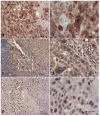BUBR1 as a Prognostic Biomarker in Canine Oral Squamous Cell Carcinoma
- PMID: 36428310
- PMCID: PMC9687056
- DOI: 10.3390/ani12223082
BUBR1 as a Prognostic Biomarker in Canine Oral Squamous Cell Carcinoma
Abstract
Chromosomal instability (CIN) plays a key role in the carcinogenesis of several human cancers and can be related to the deregulation of core components of the spindle assembly checkpoint (SAC) including BUBR1 protein kinase. These proteins have been related to tumor development and poor survival rates in human patients with oral squamous cell carcinoma (OSCC). To investigate the expression of the SAC proteins BUBR1, BUB3 and SPINDLY and also Ki-67 in canine OSCC, we performed an immunohistochemical evaluation in 60 canine OSCCs and compared them with clinical and pathological variables. BUBR1, Ki-67, BUB3 and SPINDLY protein expressions were detected in all cases and classified as with a high-expression extent score in 31 (51.7%) cases for BUBR1, 33 (58.9%) cases for BUB3 and 28 (50.9%) cases for SPINDLY. Ki-67 high expression was observed in 14 (25%) cases. An independent prognostic value for BUBR1 was found, where high BUBR1 expression was associated with lower survival (p = 0.012). These results indicate that BUBR1 expression is an independent prognostic factor in these tumors, suggesting the potential use for clinical applications as a prognostic biomarker and also as a pharmacological target in canine OSCC.
Keywords: BUB3; BUBR1; Ki-67; SPINDLY; immunohistochemistry; oral cancer; prognostic markers; survival.
Conflict of interest statement
The authors declare no conflict of interest.
Figures







Similar articles
-
Spindly and Bub3 expression in oral cancer: Prognostic and therapeutic implications.Oral Dis. 2019 Jul;25(5):1291-1301. doi: 10.1111/odi.13089. Epub 2019 Apr 4. Oral Dis. 2019. PMID: 30866167
-
[Expression and clinical significance of Spindly and Bub3 in oral squamous cell carcinoma].Shanghai Kou Qiang Yi Xue. 2020 Oct;29(5):528-532. Shanghai Kou Qiang Yi Xue. 2020. PMID: 33543222 Chinese.
-
Functional and Structural Characterization of Bub3·BubR1 Interactions Required for Spindle Assembly Checkpoint Signaling in Human Cells.J Biol Chem. 2016 May 20;291(21):11252-67. doi: 10.1074/jbc.M115.702142. Epub 2016 Mar 30. J Biol Chem. 2016. PMID: 27030009 Free PMC article.
-
BubR1 kinase: protection against aneuploidy and premature aging.Trends Mol Med. 2015 Jun;21(6):364-72. doi: 10.1016/j.molmed.2015.04.003. Epub 2015 May 8. Trends Mol Med. 2015. PMID: 25964054 Review.
-
Research progress of Bub3 gene in malignant tumors.Cell Biol Int. 2022 May;46(5):673-682. doi: 10.1002/cbin.11740. Epub 2022 Feb 24. Cell Biol Int. 2022. PMID: 34882895 Free PMC article. Review.
Cited by
-
Centromeres in cancer: Unraveling the link between chromosomal instability and tumorigenesis.Med Oncol. 2024 Oct 1;41(11):254. doi: 10.1007/s12032-024-02524-0. Med Oncol. 2024. PMID: 39352464 Review.
-
The Predictive Value of BUB1 in the Prognosis of Oral Squamous Cell Carcinoma.Int Dent J. 2025 Apr;75(2):1165-1175. doi: 10.1016/j.identj.2024.07.012. Epub 2024 Aug 15. Int Dent J. 2025. PMID: 39147662 Free PMC article.
-
Immunohistochemical Expression Levels of Epidermal Growth Factor Receptor, Cyclooxygenase-2, and Ki-67 in Canine Cutaneous Squamous Cell Carcinomas.Curr Issues Mol Biol. 2024 May 19;46(5):4951-4967. doi: 10.3390/cimb46050297. Curr Issues Mol Biol. 2024. PMID: 38785565 Free PMC article.
References
-
- Vail D.M., Thamm D., Liptak J. Withrow and MacEwen’s Small Animal Clinical Oncology—E-Book. Elsevier Health Sciences; Amsterdam, The Netherlands: 2019.
Grants and funding
LinkOut - more resources
Full Text Sources
Miscellaneous

